Are you searching for the very best bottle for your breastfed baby? There are so many things, as a new mama, that we have to learn and keep up with. It seriously makes me exhausted just thinking about it all. As a labor and delivery nurse, I felt like I had a pretty good grasp on all things birth, postpartum, and breastfeeding related but boy was I wrong.
Today is all about bottles for breastfed babies. I’m going to unpack what to look for and tell you some of my personal favorites. This certainly should not be the extent of your breastfeeding prep but consider this to be an important part of it!
Follow @mommy.labornurse on Instagram to join our community of over 650k for education, tips, and solidarity on all things pregnancy, birth, and postpartum!
Things to consider
I’ll start by saying this, not all babies are created equal! What works for one baby may or may not work for another. You might have to try several bottles to find one that suits your little one’s needs. Below are some different things you might want to consider when shopping for the best bottle for a breastfed baby.
Nipple size
If you are a new mama or a soon to be new mama you might not know that baby nipples actually come in different sizes. The reason for this is to control the milk flow and speed according to baby’s age and / or liking.
Typically, the size of the nipple correlates to baby’s age, but this isn’t always the case. The smallest nipple is a size 0 or a ‘P’ and this is most commonly used for preemies and some newborns. A level 1 nipple is usually for 0 months of age and up, a level 2 for 3 months +, and so on and so on.
This nipple size and baby age recommendation is simply that, just a recommendation. I have heard of some baby’s that stay on a level 1 nipple until they transition off the bottle and then some babies that quickly progress to a level 4. More important than the age of your baby is how your baby is tolerating the flow of milk.
I would recommend having some size 0 and size 1 nipples on hand before baby is born. You just never know if you are going to end up with a baby that needs that super slow flow or a guzzler.
Nipple shape
Just as all bottle nipple sizes are different, so are bottle nipple shapes. Makes sense, not all nipples are created equal, ammirite ladies?! You are going to find a lot of bottles out there that claim to mimic the natural shape of a breast. Well lemme tell you something, everybody’s breast ain’t the same and everybody has a different opinion about which kind of nipple is best for breastfed babies.
A standard bottle nipple is long with a narrow base. Other, less common bottle nipples, are shorter in length, curved at the tip, have a wide base, among other things. I know you aren’t supposed to assume things but for this situation, I would assume your baby will take a standard bottle nipple without any issue.
Purchasing multiple nipple sizes is one thing but having several different nipple shapes on hand is probably not necessary. Most babies, whether breastfed or strictly bottle fed, don’t have an issue with the standard nipple. I would hate for you to spend money on all these different kinds of bottles when it might be irrelevant and unnecessary.
If you get desperate, you can always overnight yourself some from Amazon. you definitely wouldn’t be the first to do this!
Design and material
The two big ones you will see when it comes to bottle materials are glass and plastic. I would definitely say plastic bottles are far more common these days but you can still find glass ones out there if that’s what you are after.
As with most things in life, there are potential risks associated with plastic bottles. I will link a Cleveland Clinic article that spells it out better than I can but here’s the bottom line – further research is needed to determine if the microscopic plastic particles (“microparticles”) affect health, so use plastic baby bottles with caution.
To learn more about how to be cautious when using plastic bottles and more information about plastic bottle safety be sure to check out the Cleveland Clinic article here.
Lastly, there are now hybrid baby bottles on the market. I personally didn’t use these with my boys (not even sure if they weren’t out yet or I just didn’t know about them at that time) but it seems like a really great alternative to plastic and glass.
The particular hybrid bottle I was reading about, the Chicco Duo, is 100% pure glass on the inside and premium plastic on the outside. The inner glass layer keeps plastic from coming in contact with milk and the outer plastic layer means it’s much harder to break.
Venting system
Some bottle companies include a venting system in their bottles. The goal of a venting system is to reduce the amount of air that gets into baby’s belly to reduce or eliminate gas, colic, burping, and spitting up.
Dr. Brown’s is the big one when it comes to venting systems. The advantage of these bottles is that they decrease the amount of gastrointestinal difficulties your baby experiences. The downside is that you have more bottle parts to clean. In addition to already having to wash the bottle, the nipple, and the nipple ring, you also have 2 extra pieces to clean with the venting system.
If you are asking me, the 2 extra pieces to clean are totallyyyy worth it if they keep your little one’s tummy troubles at bay.
When should I introduce a bottle?
Different people have different thoughts about this so I encourage you to spend a little time doing your own research. Most people recommend waiting until breastfeeding is well established before introducing a bottle.
What does well established mean? Well established means different things for different mamas but for most women it’s around the 4 week mark. Here me out – I have been a new mama, struggling with breastfeeding, I’ve been in your shoes and I am all about supporting mama’s mental health. If your baby is 2 weeks old and you want to pump a little milk to give yourself a break or a few extra zzz’s, go for it!
New mamas often get so focused on and consumed with breastfeeding that they neglect their own needs. Breastmilk is important, yeah, but you know what else is? Your mental health! Your baby needs a happy and mentally healthy mama more than they need breastmilk. Thanks for coming to my TED talk!
Related Reading: 5 Life Changing Ways to Overcome Postpartum Anxiety
What about nipple confusion?
Nipple confusion refers to a situation where a baby has difficulty switching between a bottle nipple and breastfeeding. Nipple confusion is essentially the reason why most experts in the breastfeeding world recommend waiting before introducing a bottle or pacifier.
There are things you can do to try and avoid nipple confusion with your little one but some babies are just more prone to it than others. La Leche League, a wonderful resource for breastfeeding information, has some specific tips and information regarding nipple confusion that you can find here.
The 6 best bottles for breastfed babies
1. Comotomo
The nipple and body of the bottle are both made of 100% hygienic silicone. It is a vented bottle system with dual anti-colic vents that help prevent unwanted air-intake and reduce colic. The bottles are designed to closely mimic breastfeeding to reduce bottle rejection and nipple confusion.
Comotomo bottles are safe in the microwave, dishwasher, sterilizer, and boiling water. The wide opening makes for easier cleaning too!
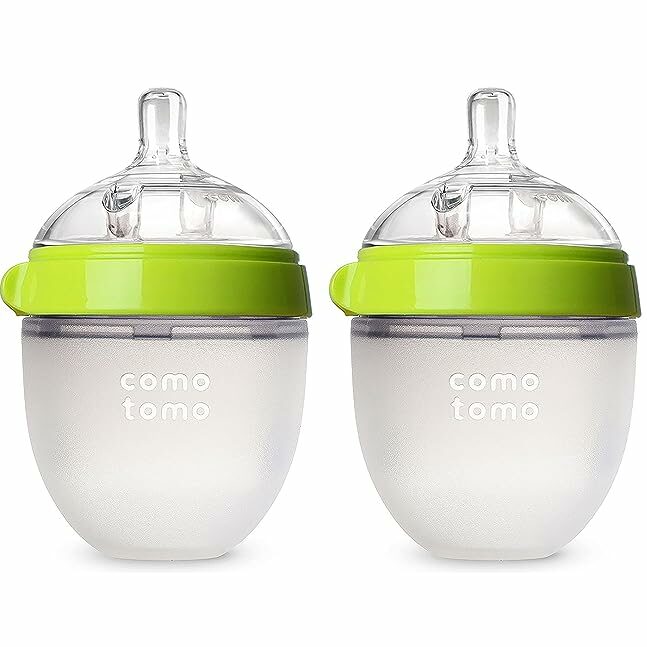
2. Philips AVENT Natural Response
These bottles are designed with a unique opening and tip which only releases milk when baby actively drinks. When baby pauses to swallow and breathe, milk does not flow, just like with breastfeeding! This gives baby the ability to control the pace.
This bottle offers a wide breast-shaped nipple with a soft feel that mimics the breast. It also has a built in anti-colic valve that is designed to reduce colic and tummy discomfort.
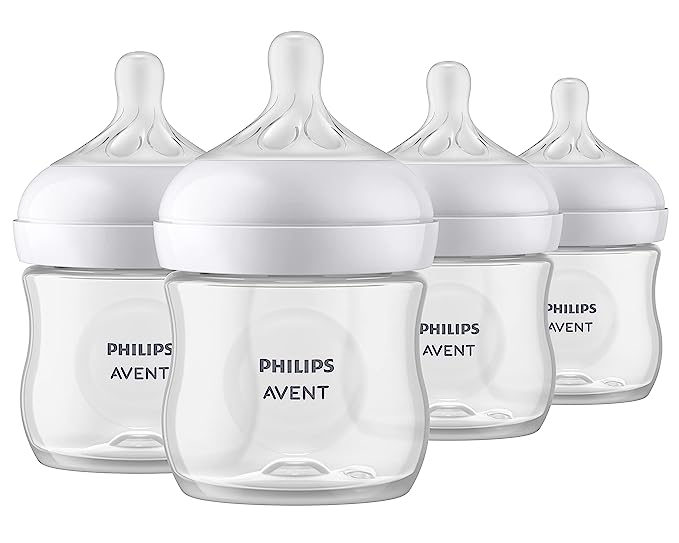
3. Lansinoh Anti-Colic
Lansinoh’s natural wave nipples are clinically proven to reduce nipple confusion for breastfed babies. They are also designed to reduce the intake of air to help minimize symptoms associated with gas, colic, and spit up. The nipple is made with 100% silicone that’s soft, flexible, and designed for optimal compression.
The bottles, containing only 4 pieces, are easy to clean and assemble and are dishwasher-safe.
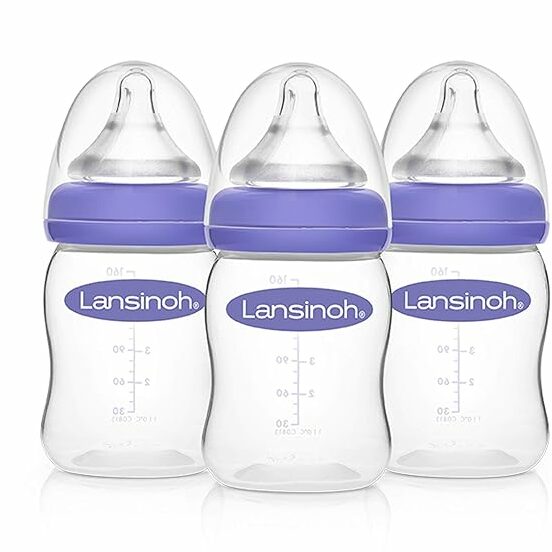
4. Dr. Brown Natural Flow Anti-Colic
These bottles have an anti-colic internal vent system that is clinically proven to reduce colic and decrease spit-up, burping, and gas. It is also proven to help preserve bottle milk nutrients and aid in digestion.
The breast-like nipple shape encourages a proper latch for a more natural bottle feeding experience. This also helps to ease the transition between breast and bottle. The nipples also provide a consistent flow that allows baby to feed at their own pace.
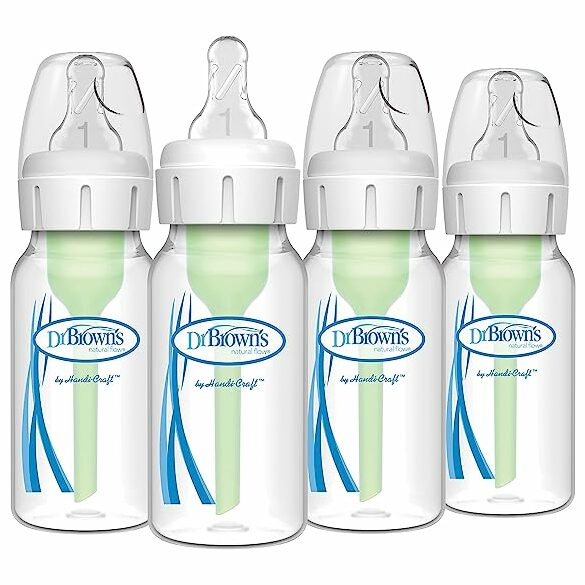
5. Nanobebe Flexy Silicone
Nanobebe Flexy bottles offer an advanced 360 degree, triple vented, non-collapsible nipple design to encourage a perfect latch. The nipple has an extra-soft and familiar feel, making it easier to transition between breast and bottle.
Made from the highest grade silicone, these bottles are dishwasher and microwave safe. The stable, wide base on the bottle keeps it from easily tipping over.

6. Tommee Tippee Natural Start
These bottle nipples are made from soft silicone and have a special breast-like shape. The nipple encourages a natural latch and prevents nipple confusion when switching between breast and bottle. Not only does the nipple flex and stretch like a real breast it also allows your baby to feed comfortably at their own pace.
When the screw ring, nipple, and cap are all secured, the bottle is completely mess-free and leakproof. They also offer an innovative anti-colic valve which prevents excessive air from getting into the milk.
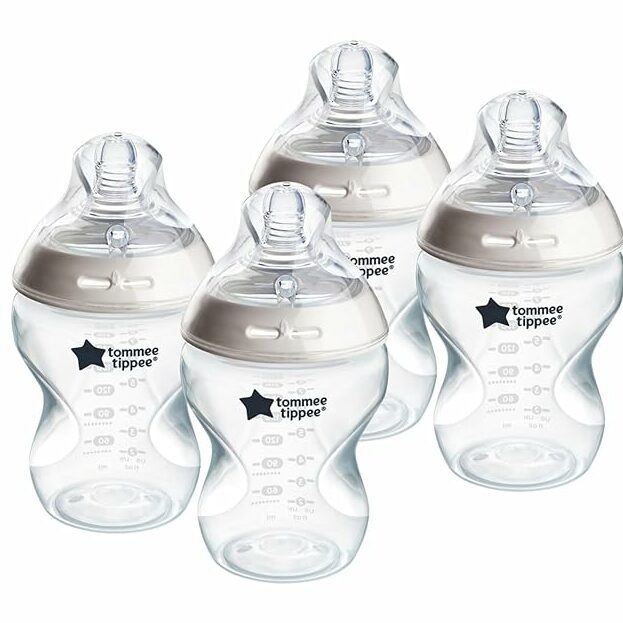
Looking for more breastfeeding content?
I don’t identify as a lactation consultant, professionally, but I have offered many mamas breastfeeding support in the immediate postpartum period. I have also breastfed, with some definite hurdles, two babies of my own.
The resources I will link below are not meant to take the place of a breastfeeding course. Do yourself a favor, if you plan on breastfeeding, go ahead and sign up for one of Milkology’s awesome courses! I can assure you that you will not regret it! You can find the link to their site here. You can also use promo code MLN10 to score an extra 10% off their already very reasonably priced course!
In the meantime I have linked some MLN breastfeeding content below for you to peruse.





